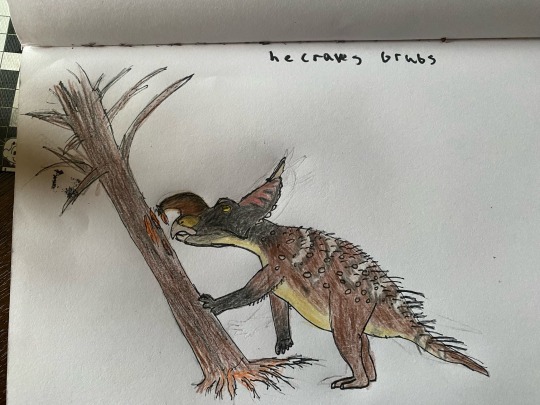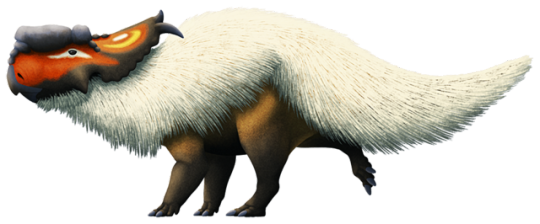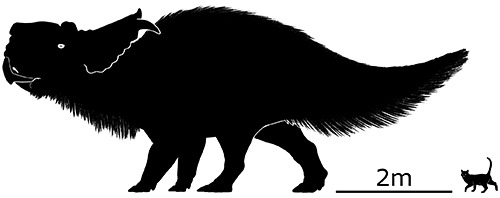#pachyrhinosaurini
Explore tagged Tumblr posts
Text


Einiosaurus and Achelousaurus
#ceratopsian#einiosaurus#pachyrhinosaurus#pachyrhinosaurini#evolution#dinosaur#art#irl art#pterosaur#bird
8 notes
·
View notes
Note
Have you done an MH tree for herbivores yet, or were we just not paying attention?
I actually don’t think I will because the herbivore classification is just for “small” monsters that eat plants. It’s sort of a dubious class since technically the Blos wyverns and Gammoth would technically fall under that category.
But I can tell you what I think the various herbivores are!
Gastodon and Kestodon are technically brute wyverns related to Banbaro according to the canon trees, and honestly that actually makes quite a lot of sense and is pretty interesting so I agree! But I do have non-carnivorous brutes as heterodontosaurs.
As for the various mammals in the class… Burukku is pretty obviously a buffalo, and Erupe and Anteka are goats. Moofah seems to be a sheep. Mosswine is a pig. Kelbi actually feels like an Antilocaprid to me, which would make it related to giraffes. Popo I have as the closest living relatives of Gammoth, which together are descendants of early Proboscideans that split off from all other more “normal” members.
Epioth I actually covered in my recent tree!
Larinoth feels like a titanosaur of some kind, albeit an odd one. Both Slagtoth and Rhenoplos are ceratopsians, and Slagtoth in particular feels like a member of the Pachyrhinosaurini. Aptonoth seems to be a heavily armored Lambeosaurine. Apceros… I’m not so sure on. Ankylosaur is tempting but it’s shell is very different from them, so “Thyreophoran” is as much as I can narrow it down.
Gowngoat… I don’t know. It’s got this weird mish mash of dinosaur and goat traits. Maybe ornithopod??
#ask#questions#dappercritter#monhun#monster hunter#monsterhunter#monster hunter biology#speculative biology#speculative evolution
10 notes
·
View notes
Photo

Ceratopsian Month #17 -- Pachyrhinosaurus canadensis
Pachyrhinosaurus (“thick-nosed lizard”) has become one of the more recognizable ceratopsian names in the last couple of decades, but its remains have actually been known for over 70 years, first discovered in the mid-1940s.
Three different species have been named within the genus, all living about 74-69 million years ago in Alberta, Canada, and Alaska, USA. The type species P. canadensis dates to roughly the middle of that time span, at an age of around 71 million years.
It was one of the largest of the centrosaurs, with the biggest specimens estimated to have measured up to 8m long (26′). Thousands of fossils have been found in a bone bed that seems to represent a mass mortality event -- possibly a herd caught in a flash flood -- with ages ranging from juveniles to adults.

Rather than horns, Pachyrhinosaurus had huge flattened bosses on its skull, which nearly grew together into a single large mass in both P. canandensis and the younger species P. perotorum. The older species P. lakustai instead had more separated bosses and a “unicorn horn” on its forehead.
(I’m also hardly the first person to speculate about fluffy pachyrhinosaurs, but since they lived in a chilly Arctic environment it’s certainly an interesting possibility.)
#science illustration#paleontology#paleoart#palaeoblr#ceratopsian month 2017#pachyrhinosaurus#pachyrhinosaurini#centrosaurinae#ceratopsidae#neoceratopsia#ceratopsian#marginocephalia#neornithischia#ornithischia#dinosaur#archosaur#art#speculative fluffiness#feather ALL the dinosaurs
219 notes
·
View notes
Text
Pachyrhinosaurus canadensis
('thick-nosed reptile, from Canada')
Centrosaurinae Pachyrhinosaurini
Pachyrhinosaurus is represented by three species.
P. lakustai ('for Al Lakusta'): the geologically-oldest species; found in the Wapiti Formation of Alberta, ~73.5 - 72.5 Ma; distinguishable in part by a unicorn-style horn on the parietal bone at the centre of the frill, behind the eyes.
Chronologically next is P. canadensis: this is the type species and largest of the bunch; Horseshoe Canyon Formation and contemporary St. Mary River Formation, also in Alberta, ~71.5 - 71 Ma.
The youngest species is P. perotorum ('for Ross Perot'), from the Prince Creek Formation on the North Slope of Alaska, ~70 - 69 Ma; truly an Arctic dinosaur, at least for the summer months.
Pachyrhinosaurus, Achelousaurus, and Einiosaurus together form the tribe Pachyrhinosaurini.
Alberta, Canada, and Alaska, USA.
Upper Cretaceous.
~
Artwork by Sergey Krasovskiy.

Daily Dino Fact #7
(I was busy, sorry for the late update)
22 notes
·
View notes
Text
Pachyrhinosaurus canadensis, P. lakustai, P. perotorum

By José Carlos Cortés on @ryuukibart
PLEASE support us on Patreon! We really do need all of your support to keep this blog running - any amount helps!
Name: Pachyrhinosaurus canadensis, P. lakustai, P. perotorum
Name Meaning: Thick-nosed Reptile
First Described: 1950
Described By: Sternberg
Classification: Dinosauria, Ornithischia, Genasauria, Neornithischia, Cerapoda, Marginocephalia, Ceratopsia, Neoceratopsia, Coronosauria, Ceratopsoidea, Ceratopsidae, Centrosaurinae, Pachyrhinosaurini, Pachyrostra
Pachyrhinosaurus is one of the more famous Ceratopsians, due to its widespread prevalence and distinctive nose lump. Indeed, it was one of the more common Centrosaurines, not restricted to a single area of Canada but rather found in Alaska and Canada, and not limited to the Campanian but living from 73.5 to 69 million years ago, from the latest Campanian to the Maastrichtian ages of the Late Cretaceous. It was first found in the Horseshoe Canyon Formation of Alberta, and then other remains were found in the St. Mary River Formation in Alberta as well. Further remains were found in the Kikak-Tegoseak Quarry in northernmost Alaska. As such, though there is no known evidence of such, it is not unreasonable to suppose that Pachyrhinosaurus may have supported feather filaments like its distant cousins Kulindadromeus and Psittacosaurus for warmth; much like a wooly rhinoceros. Though this is a controversial idea, it is not outside the realm of possibility; really, it depends primarily on the actual plasticity of filamentous integument in non-avian dinosaurs. So, we include a feathered Pachyrhinosaurus here too; very well equipped to defend itself against the cold of the Cretaceous Arctic.

By Karen Carr, CC BY 2.5
Pachyrhinosaurus could get to be up to 8 meters long, weighing four tonnes and having strong teeth to chew tough plants. The flattened lump over the nose and eyes were accompanied by horns on the frill; though in P. perotorum and some specimens of P. lakustai two backward pointing horns found on other members of the genus are not present. Instead, P. perotorum had flattened horns on the top edge of the frill, and P. lakustai had a comb horn from the middle of the frill behind the eyes. This diversity of ornaments on their skulls is likely due to the influence of sexual selection. P. canadensis and P. lakustai are known from the formations in Alberta, while P. perotorum is known from Alaska. As a young animal, its ornamentation is much diminished, including the lump on the nose; as it grew bigger so did the ornamentation, strengthening the case for sexual selection being at work.

By Jack Wood on @thewoodparable
In the St. Mary River Formation, Pachyrhinosaurus lived alongside many other dinosaurs such as Anchiceratops, Montanoceratops, Edmontonia, Edmontosaurus, Saurornitholestes, Troodon, Thescelosaurus, Albertosaurus, and many other non-dinosaurs. In the Horseshoe Canyon Formation, it lived alongside such animals as Anodontosaurus, Edmontonia, Euoplocephalus, Atrociraptor, Epichirostenotes, Richardoestesia, Paronychodon, Albertonykus, Dromiceiomimus, Ornithomimus, Struthiomimus, Stegoceras, Sphaerotholus, Parksosaurus, Edmontosaurus, Hypacrosaurus, Saurolophus, Anchiceratops, Arrhinoceratops, Eotriceratops, Montanaceratops, Albertosaurus, Gorgosaurus, and Daspletosaurus. In both, it lived in a floodplain environment, near the inland sea.
Sources:
https://en.wikipedia.org/wiki/Pachyrhinosaurus
http://markwitton-com.blogspot.com/2015/02/controversial-ceratopsids-revisited.html
Shout out goes to @allysharp!
#pachyrhinosaurus#dinosaur#ceratopsian#feathered pachyrhinosaurus#palaeoblr#pachyrhinosaurus canadensis#pachyrhinosaurus lakustai#pachyrhinosaurus perotorum#paleontology#prehistory#prehistoric life#dinosaurs#biology#a dinosaur a day#a-dinosaur-a-day#dinosaur of the day#dinosaur-of-the-day#science#nature#factfile#allysharp#Dìneasar#डायनासोर#ديناصور#ডাইনোসর#risaeðla#ڈایناسور#deinosor#恐龍#恐龙
83 notes
·
View notes
Photo

Ceratopsian Month #15 -- Einiosaurus procurvicornis
Einiosaurus (“buffalo lizard”) was part of a branch of the centrosaurs known as the Pachyrhinosaurini, a group with especially elaborate nose ornamentation.
Living about 74 million years ago in Montana, USA, it’s known from hundreds of bones representing over fifteen different individuals of varying ages. It had little-to-no brow horns, and two long spikes at the top of its frill -- but also one of the most unusual-looking nose horns of all the ceratopsids, curving strongly forward and downward into a large hooked shape.

The juvenile remains show evidence of very rapid growth during their first few years of life, only starting to slow down around age 3-5, suggesting that was the point they began to reach reproductive maturity. The largest specimens are estimated to have measured about 4.5m long (14′9″), although they appear to have been subadults who still hadn’t quite reached their full size.
#science illustration#paleontology#paleoart#palaeoblr#ceratopsian month 2017#einiosaurus#pachyrhinosaurini#centrosaurinae#ceratopsidae#neoceratopsia#ceratopsian#marginocephalia#neornithischia#ornithischia#dinosaur#archosaur#art#go home evolution you're drunk
180 notes
·
View notes
Photo

Ceratopsian Month #16 -- Achelousaurus horneri
Achelousaurus (“Achelous lizard”) seems to have been a transitional form among the Pachyrhinosaurini. While slightly more basal members like Einiosaurus had well-developed nose horns, and the later Pachyrhinosaurus had enormous flattened nasal bosses, Achelousaurus was somewhere in-between.
Living in Montana, USA, about 74 million years ago, it reached sizes of about 6m long (19′8″). Instead of horns, rough patches of bone on its skull supported bosses over its snout and eyes, which in life would have been covered by thick layers of keratinous skin.

Unlike adults, juveniles had small brow horns with bony cores which gradually developed into full bosses as they grew. It’s possible that the bosses of mature individuals were used for headbutting or ramming behaviors.
#science illustration#paleontology#paleoart#palaeoblr#ceratopsian month 2017#achelousaurus#pachyrhinosaurini#centrosaurinae#ceratopsidae#neoceratopsia#ceratopsian#marginocephalia#neornithischia#ornithischia#dinosaur#archosaur#art#speculative fluffiness#feather ALL the dinosaurs
149 notes
·
View notes
Text
Pachyrhinosaurus canadensis
('thick-nosed reptile, from Canada')
Centrosaurinae Pachyrhinosaurini
Pachyrhinosaurus is the most species-rich genus of ceratopsid, represented by three species.
P. lakustai ('for Al Lakusta'): the geologically-oldest species; found in the Wapiti Formation of Alberta, ~73.5 - 72.5 Ma; distinguishable in part by a unicorn-style horn on the parietal bone at the centre of the frill, behind the eyes.
Chronologically next is P. canadensis: this is the type species and largest of the bunch; Horseshoe Canyon Formation and contemporary St. Mary River Formation, also in Alberta, ~71.5 - 71 Ma.
The youngest species is P. perotorum ('for Ross Perot'): from the Prince Creek Formation on the North Slope of Alaska, ~70 - 69 Ma; truly an Arctic dinosaur, at least for the summer months; was likely migratory.
Pachyrhinosaurus, Achelousaurus, and Einiosaurus together form the tribe Pachyrhinosaurini.
Alberta, Canada, and Alaska, USA.
Upper Cretaceous.
~
Artwork by Sergey Krasovskiy.

Daily Dino Fact #17
4 notes
·
View notes
Text
Achelousaurus horneri

By Jack Wood on @thewoodparable
PLEASE support us on Patreon! We really do need all of your support to keep this blog running - any amount helps!
Name: Achelousaurus horneri
Name Meaning: Achelou’s Reptile
First Described: 1995
Described By: Sampson
Classification: Dinosauria, Ornithischia, Genasauria, Neornithischia, Cerapoda, Marginocephalia, Ceratopsia, Neoceratopsia, Coronosauria, Ceratopsoidea, Ceratopsidae, Centrosaurinae, Pachyrhinosaurini, Pachyrostra
Achelousaurus is a close relative of Pachyrhinosaurus that also had a large, lumpy horn on its nose. It lived about 74.2 million years ago, in the Campanian age of the Late Cretaceous, in the Two Medicine Formation of Montana. It also had very raised bony projections over it’s eyes, giving it a rather characteristic face, and it probably would have looked like it was giving you a look if you encountered one in real life.

Like this. By Mariana Ruiz, in the Public Domain
It is known from three skulls and some postcranial material, and though its size has not been fully estimated, its skull could be up to 1.6 meters long, given that it had a large frill with big frill horns to boot. In it’s formation it lived along with many other dinosaurs such as Prosaurolophus, Scolosaurus, Hypacrosaurus, Einiosaurus, and indeterminant tyrannosaurids that probably preyed upon it.
Source:
https://en.wikipedia.org/wiki/Achelousaurus
Shout out goes to @hullk92!
#achelousaurus#achelousaurus horneri#dinosaur#ceratopsian#palaeoblr#paleontology#prehistory#prehistoric life#dinosaurs#biology#a dinosaur a day#a-dinosaur-a-day#dinosaur of the day#dinosaur-of-the-day#science#nature#factfile#hullk92#Dìneasar#डायनासोर#ديناصور#ডাইনোসর#risaeðla#ڈایناسور#deinosor#恐龍#恐龙#динозавр#dinosaurio#공룡
91 notes
·
View notes
Text
Einiosaurus procurvicornis

By Jack Wood on @thewoodparable
PLEASE support us on Patreon! We really do need all of your support to keep this blog running - any amount helps!
Name: Einiosaurus procurvicornis
Name Meaning: Buffalo Reptile
First Described: 1995
Described By: Sampson
Classification: Dinosauria, Ornithischia, Genasauria, Neornithischia, Cerapoda, Marginocephalia, Ceratopsia, Neoceratopsia, Coronosauria, Ceratopsoidea, Ceratopsidae, Centrosaurinae, Pachyrhinosaurini
Einiosaurus is a distinctive Ceratopsian, with a large, downward curved nose horn, looking much like that of a bottle opener (so I’m sure there would be a market for Einiosaurus bottle openers. It had short eyebrow horns, and spikes on its fairly small frill, as well as small osteoderms. It was probably about 4.5 meters long. It grew fast for the first three to five years of its life, when growth slowed with sexual maturity. It lived inland in the Two Medicine Formation, living about 74.5 million years ago in the Campanian age of the Late Cretaceous. As such, it lived alongside many other dinosaurs such as Hypacrosaurus, Maiasaura, Prosaurolophus, Orodromeus, Edmontonia, Euoplocephalus, Daspletosaurus, Bambiraptor, Chirostenotes, Troodon, and Avisaurus. It lived in a warm, semi-arid environment, and is known from several specimens.
Source:
https://en.wikipedia.org/wiki/Einiosaurus
Shout out goes to @yourboyrichard!
#einiosaurus#einiosaurus procurvicornis#dinosaur#ceratopsian#palaeoblr#paleontology#prehistory#prehistoric life#dinosaurs#biology#a dinosaur a day#a-dinosaur-a-day#dinosaur of the day#dinosaur-of-the-day#science#nature#factfile#yourboyrichard#Dìneasar#डायनासोर#ديناصور#ডাইনোসর#risaeðla#ڈایناسور#deinosor#恐龍#恐龙#динозавр#dinosaurio#공룡
77 notes
·
View notes
Text
Sinoceratops zhuchengensis

By Jack Wood on @thewoodparable
PLEASE support us on Patreon! We really do need all of your support to keep this blog running - any amount helps!
Name: Sinoceratops zhuchengensis
Name Meaning: Chinese Horned Face
First Described: 2010
Described By: Xu et al.
Classification: Dinosauria, Ornithischia, Genasauria, Neornithischia, Cerapoda, Marginocephalia, Ceratopsia, Neoceratopsia, Coronosauria, Ceratopsoidea, Ceratopsidae, Centrosaurinae, Pachyrhinosaurini
Sinoceratops is a fairly poorly known Ceratopsian, with only parts of the skull and the braincase known, which has allowed for some reconstruction of the animal but not much. It was found in the Xingezhuang Formation of the Wangshi Group in Shandong, China, and lived about 72 million years ago, in the Maastrichtian age of the Cretaceous period. As for now, it is the only Ceratopsid known from Asia, indicating that their diversification did reach this location. Due to its sparse remains, any size estimates are rough; it’s thought to have been 6 meters long and 2 meters tall. It lived alongside other dinosaurs such as Zuchengceratops, Huaxiaosaurus, Zhuchengosaurus, and Zhuchengtyrannus, which may have fed on Sinoceratops.
Source:
https://en.wikipedia.org/wiki/Sinoceratops
Shout out goes to @tempestuousbitch!
#sinoceratops#sinoceratops zhuchengensis#dinosaur#ceratopsian#palaeoblr#paleontology#prehistory#prehistoric life#dinosaurs#biology#a dinosaur a day#a-dinosaur-a-day#dinosaur of the day#dinosaur-of-the-day#science#nature#factfile#tempestuousbitch#Dìneasar#डायनासोर#ديناصور#ডাইনোসর#risaeðla#ڈایناسور#deinosor#恐龍#恐龙#динозавр#dinosaurio#공룡
50 notes
·
View notes